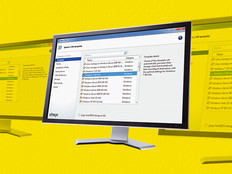Business Intelligence
From Transactions to Transformation
You need a smart strategy for spinning raw data into gold.
Many universities and colleges are drowning in data — the institutional data they’ve collected to improve performance and meet demands for accountability.
Consider the sheer volume of data generated at any institution. On a given day, prospective students submit applications for admission, faculty log assignment grades, the business office runs payroll, alumni contribute to the annual fund, and a professor wins a foundation grant to conduct new research.
That information piles up quickly. The student information system (SIS), course management system (CMS), enterprise resource planning (ERP) system and other mission-critical applications overflow with information. Yet, few administrators can use this data to improve institutional performance. Generating a custom report often requires a trip to the information technology department and spending considerable time and resources. Even then, there’s no guarantee of success.
Business Intelligence can simplify this process, but only if administrators understand what BI is and what it does. BI systems differ from reporting tools in that they provide insight into institutional performance rather than an account of its transactions.
Of course, transactional reports are still necessary to answer important questions such as, “What happened, who did it and when did it happen?” Most SIS and CMS platforms provide tools to generate these types of reports as a standard feature. BI systems go a step further. They answer “Why did it happen, how will it happen in the future and what can we do about it?” Finding these answers requires a reporting application that can draw data from multiple sources and provide users with sophisticated models for analysis. A standard reporting tool lacks this type of functionality.
BI Layers
Any true BI system has three layers: data integration, the BI platform and service delivery.
Data integration consists of extract, transform and load functionality, data-cleansing tools and the data warehouse.
The BI platform is the heart and soul of a BI system, and includes engines for analytics, rules and processes, service delivery and collaboration. It also offers administration and management functionality, data mining, developer tools and the services for storage and BI portals.
Service delivery is the only layer with which most users will interact. It includes analytics and query, advanced analytics, visualization tools (graphs, charts and tables), performance services (forecasting, planning and budgeting), scorecards and dashboards, modeling and online analytical processing.
These layers connect to drive the value of BI beyond that offered by transactional reports. They form a chain that ensures the quality of institutional data, limits access to authorized users and enables users to perform analysis ranging from the mundane to the complex.
According to a recent Datamonitor study, only 12 percent of higher ed institutions said they were using a BI solution and 18 percent planned on implementing BI in 2007.
What’s stopping them? Price is always a factor in buying new technology, and BI systems can run into the millions of dollars. But the study suggested that confusion about how BI differs from SIS, ERP and other reporting tools impedes adoption.
At the most fundamental level, choosing to implement a BI system is not entirely a technology decision. The decision also involves making an institutional change. Achieving full value depends almost as much upon reaching consensus about what constitutes institutional effectiveness and how to measure it as it does upon choosing the right BI tools.






